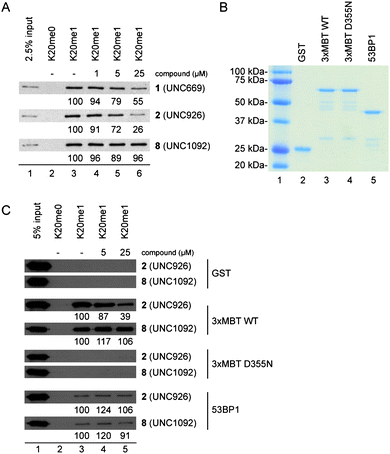
| Size | Price | Stock | Qty |
|---|---|---|---|
| 5mg |
|
||
| 10mg |
|
||
| 25mg |
|
||
| 50mg |
|
||
| 100mg |
|
||
| 250mg |
|
||
| 500mg | |||
| Other Sizes |
UNC-926 is a potent and selective inhibitor of the L3MBTL1 (Lethal(3)malignant brain tumor-like protein) domain (Kd = 3.9 μM), which is a methyl-lysine (Kme) reader domain. UNC-926 acts by binding to the MBT domain of the L3MBTL1 protein. In a peptide pull down assay, UNC-926 was found to be able to selectively inhibits the L3MBTL13XMBT-H4K20me1 interaction.
| ln Vitro |
In addition, UNC926 shows no binding to CBX7 and a low micromolar affinity (IC50 of 3.2 μM) for the near homolog L3MBTL3 along with a decrease in affinity for the other MBT domains[1]. UNC926 (1–25 μM) prevents the 3xMBT domain from attaching to H4K20me1. In a dose-dependent way, UNC926 prevents L3MBTL13xMBT from interacting with the relevant histonepeptides. The fact that UNC926 has no effect on 53BP1's binding to H4K20me1 indicates that it is more selective for L3MBTL1 than 53BP1[1].
|
||
|---|---|---|---|
| ln Vivo |
|
||
| Animal Protocol |
|
||
| References |
| Molecular Formula |
C16H21BRN2O
|
|
|---|---|---|
| Molecular Weight |
337.25
|
|
| Exact Mass |
336.084
|
|
| Elemental Analysis |
C, 56.98; H, 6.28; Br, 23.69; N, 8.31; O, 4.74
|
|
| CAS # |
1184136-10-4
|
|
| Related CAS # |
UNC926 hydrochloride;1782573-49-2
|
|
| PubChem CID |
61041645
|
|
| Appearance |
White to off-white solid powder
|
|
| LogP |
3.025
|
|
| Hydrogen Bond Donor Count |
0
|
|
| Hydrogen Bond Acceptor Count |
2
|
|
| Rotatable Bond Count |
2
|
|
| Heavy Atom Count |
20
|
|
| Complexity |
335
|
|
| Defined Atom Stereocenter Count |
0
|
|
| SMILES |
O=C(C1=CC=CC(Br)=C1)N2CCC(N3CCCC3)CC2
|
|
| InChi Key |
OWGLFIKZKQOYHZ-UHFFFAOYSA-N
|
|
| InChi Code |
InChI=1S/C16H21BrN2O/c17-14-5-3-4-13(12-14)16(20)19-10-6-15(7-11-19)18-8-1-2-9-18/h3-5,12,15H,1-2,6-11H2
|
|
| Chemical Name |
|
|
| Synonyms |
|
|
| HS Tariff Code |
2934.99.9001
|
|
| Storage |
Powder -20°C 3 years 4°C 2 years In solvent -80°C 6 months -20°C 1 month |
|
| Shipping Condition |
Room temperature (This product is stable at ambient temperature for a few days during ordinary shipping and time spent in Customs)
|
| Solubility (In Vitro) |
|
|||
|---|---|---|---|---|
| Solubility (In Vivo) |
Solubility in Formulation 1: ≥ 2.5 mg/mL (7.41 mM) (saturation unknown) in 10% DMSO + 40% PEG300 + 5% Tween80 + 45% Saline (add these co-solvents sequentially from left to right, and one by one), clear solution.
For example, if 1 mL of working solution is to be prepared, you can add 100 μL of 25.0 mg/mL clear DMSO stock solution to 400 μL PEG300 and mix evenly; then add 50 μL Tween-80 to the above solution and mix evenly; then add 450 μL normal saline to adjust the volume to 1 mL. Preparation of saline: Dissolve 0.9 g of sodium chloride in 100 mL ddH₂ O to obtain a clear solution. Solubility in Formulation 2: ≥ 2.5 mg/mL (7.41 mM) (saturation unknown) in 10% DMSO + 90% (20% SBE-β-CD in Saline) (add these co-solvents sequentially from left to right, and one by one), clear solution. For example, if 1 mL of working solution is to be prepared, you can add 100 μL of 25.0 mg/mL clear DMSO stock solution to 900 μL of 20% SBE-β-CD physiological saline solution and mix evenly. Preparation of 20% SBE-β-CD in Saline (4°C,1 week): Dissolve 2 g SBE-β-CD in 10 mL saline to obtain a clear solution. View More
Solubility in Formulation 3: ≥ 2.5 mg/mL (7.41 mM) (saturation unknown) in 10% DMSO + 90% Corn Oil (add these co-solvents sequentially from left to right, and one by one), clear solution. |
| Preparing Stock Solutions | 1 mg | 5 mg | 10 mg | |
| 1 mM | 2.9652 mL | 14.8258 mL | 29.6516 mL | |
| 5 mM | 0.5930 mL | 2.9652 mL | 5.9303 mL | |
| 10 mM | 0.2965 mL | 1.4826 mL | 2.9652 mL |
*Note: Please select an appropriate solvent for the preparation of stock solution based on your experiment needs. For most products, DMSO can be used for preparing stock solutions (e.g. 5 mM, 10 mM, or 20 mM concentration); some products with high aqueous solubility may be dissolved in water directly. Solubility information is available at the above Solubility Data section. Once the stock solution is prepared, aliquot it to routine usage volumes and store at -20°C or -80°C. Avoid repeated freeze and thaw cycles.
Calculation results
Working concentration: mg/mL;
Method for preparing DMSO stock solution: mg drug pre-dissolved in μL DMSO (stock solution concentration mg/mL). Please contact us first if the concentration exceeds the DMSO solubility of the batch of drug.
Method for preparing in vivo formulation::Take μL DMSO stock solution, next add μL PEG300, mix and clarify, next addμL Tween 80, mix and clarify, next add μL ddH2O,mix and clarify.
(1) Please be sure that the solution is clear before the addition of next solvent. Dissolution methods like vortex, ultrasound or warming and heat may be used to aid dissolving.
(2) Be sure to add the solvent(s) in order.
 Compound2selectively inhibits the L3MBTL13xMBT-H4K20me1 interaction in a dose-dependent manner.Med. Chem. Commun., 2012,3, 45-51 |
|---|
 Structures of L3MBTL1/L3MBTL3 inhibitors.Bioorg Med Chem Lett.2016 Sep 15;26(18):4436-4440. |
 Compound13binds SETD8 with an IC50of 39 ± 11 μM.Bioorg Med Chem Lett.2016 Sep 15;26(18):4436-4440. |